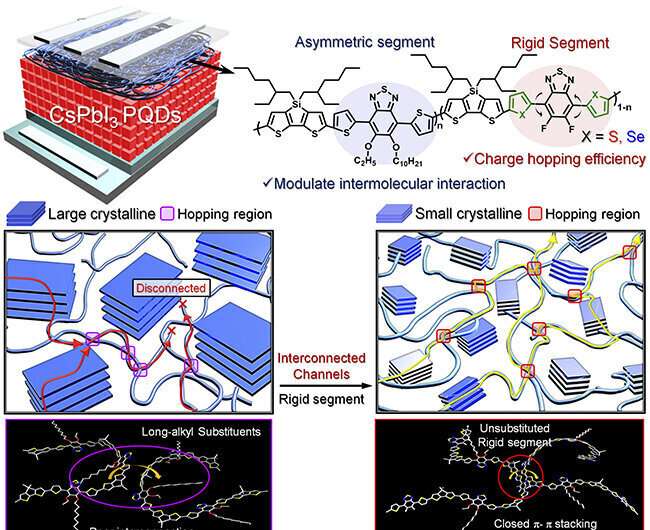Researchers at POSTECH have created novel polymeric hole transport materials to increase the efficiency of perovskite quantum dot solar cells.

Solar cells are eco-friendly power sources, reducing environmental pollution. Perovskite quantum dot cells offer lower production costs and compatibility with flexible materials, distinguishing them from conventional silicon cells. However, perovskite cell efficiency relies on hole transport materials for charge transportation. Conventional materials degrade quickly with dopants, necessitating research into dopant-free alternatives.
The research team led by Professor Taiho Park and Ph.D. candidates Dae Hwan Lee and Seyeong Lim from the Department of Chemical Engineering at POSTECH have developed a novel polymeric hole transport materials design for perovskite quantum dot solar cells. This innovation resulted in a substantial enhancement of the cells’ efficiency.
The research team developed hole transport materials comprising sulfur and selenium compound-based polymers. These polymers possess specific structural characteristics like planarization and intermolecular arrangement locking, enhancing charge mobility. Moreover, the polymers’ asymmetric alkyl substituents promote molecular interactions, effectively complementing the electrical properties of cells.
Experiments were conducted using a control group to assess the efficacy of the recently developed polymers. The findings revealed that solar cells utilizing hole transport materials containing selenium compounds achieved a power conversion efficiency (PCE) of 15.2%. Remarkably, even after 40 days, these cells retained 80% of their initial PCE, demonstrating the long-term stability and durability of the polymers. The research demonstrates that the newly developed hole transport materials can significantly enhance charge mobility in dopant-free perovskite quantum dot solar cells. Remarkably, these materials achieve the highest power conversion efficiency (PCE) and contribute to increased stability in the absence of dopants.
Professor Taiho Park, leading the research, stated that the findings mark a paradigm shift from traditional charge transport materials and anticipate their utilization in future solar cell device research.
Reference : Dae Hwan Lee et al, Tailoring Rigid Segments in Dopant-Free Polymeric Hole Transport Materials for Perovskite Quantum Dot Solar Cells, ACS Energy Letters (2023). DOI: 10.1021/acsenergylett.3c00211






